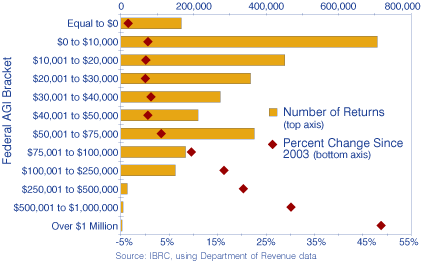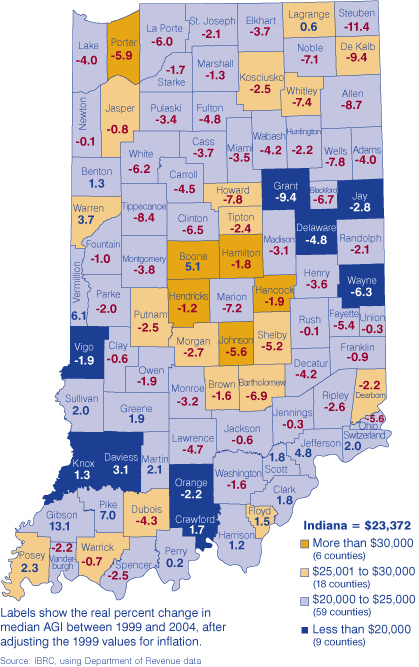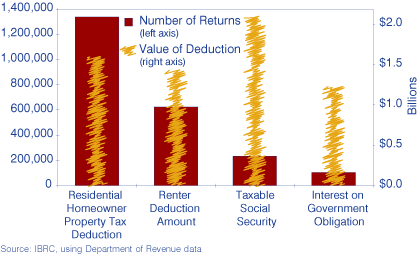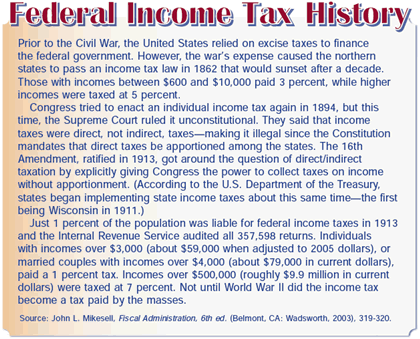Taxing Indiana—2004 Returns Reveal Much about Our Relative Wealth
Each year, the dawn of spring coincides with the arrival of one of life's inevitabilities. As the procrastinators among us scurry to complete their 1040As and IT-40s for the 2005 tax year, let us take a look at the data gleaned from the 2004 taxes we filed last year.
Indiana Returns
Over 2.89 million Indiana income tax returns were filed for 2004. This
is 56,981 more returns than the prior year, a 2 percent increase, according
to the Indiana Department of Revenue.
Figure 1 shows the distribution of returns according to their federal
adjusted gross income (AGI) bracket. Combined, the AGI for all Hoosiers
exceeded $126.5 billion. With almost a quarter of all returns, the $10,000
or less bracket was clearly the largest (706,893 returns). That category
was the largest in each of the 92 counties, ranging from 17 percent of
all Hamilton County returns to nearly 29 percent of all Knox County returns.
Figure 1: Indiana Tax Returns, 2004

The second-largest category in the vast majority of counties was the $10,001 to $20,000 bracket. For 17 suburban counties, the second-largest category was the $50,001 to $75,000 range. Hamilton County stood alone with its second-largest number of returns being those in the $100,000 to $250,000 range.
There were 2,891 returns with an AGI over $1 million for 2004, a 48.8 percent increase over the previous year. However, these high-dollar returns still account for a mere fraction of the total; Hamilton and Boone counties led the state at just 0.4 percent. Hoosier millionaires were found in all but eight counties, although they were, not surprisingly, concentrated in the state's metro areas

Median Adjusted Gross Income
Indiana's median adjusted gross income was $23,372 in 2004. This means that half of income tax returns reported AGIs above this number, while the other half were below it. At the county level, the median AGI ranged from $19,134 in Orange County to $44,512 in Hamilton County.
Indiana experienced a five-year growth of 9.7 percent ($2,062) from its median AGI of $21,310 back in 1999. Local growth rates ranged from 28.2 percent in Gibson County to a measly 0.5 percent in Steuben County.
However, if one adjusts the 1999 values for inflation, the picture is not so pleasant. When taking inflation into account, Indiana saw the purchasing power of its median AGI drop 3.3 percent. Only 21 counties, virtually all in southern Indiana, saw median AGI increase in real terms between 1999 and 2004 (see Figure 2). Gibson, Pike, Vermillion and Boone counties led the way, with inflation-adjusted AGI growth topping 5 percent. Fifteen of these 21 counties had been below the 1999 Indiana median, so they had lost ground to make up. Yet even with the gains made between 1999 and 2004, 12 of the 21 were still below the Indiana median. Gibson County, on the other hand, experienced the most dramatic growth in median AGI, jumping a remarkable 44 spots, from a rank of 74th in 1999 to a rank of 30th in 2004.
Figure 2: Median Adjusted Gross Income, 2004

Major Deductions on Indiana Tax Returns
Over 70 percent of returns claimed one Indiana deduction or another, with total deductions close to $7.7 billion. That equates to an average total deduction around $3,750 per return. While a plethora of deductions are there for the claiming, the following four deductions, as seen in Figure 3, account for over 82 percent of all Indiana deductions in dollar terms.
Figure 3: Major Indiana Deductions, 2004

Homeowner and Renter Deductions: Since everyone needs a place to live, it is not surprising that the most common were the residential homeowner property tax deduction, claimed on over 1.3 million returns, and the renter deduction, found on over 624,000 returns. Both of these deductions are capped at $2,500 per return; the average amount deducted for the residential property tax deduction was $1,197 per return, while that amount increased to $2,296 for the renter deduction. Together, these two deductions ($1.6 billion and $1.4 billion, respectively) account for about 40 percent of the value of all Indiana's deductions.
Social Security: Indiana does not tax social security benefits, so that income gets deducted from federal AGI as well. While a smaller number of returns (not quite 234,000) claim this deduction, the total value of that deduction is nearly $2.1 billion—making it Indiana's single largest, at 27 percent of all deductions. The average deductible amount was $8,957 per return.
Interest on Government Obligations: Not many people have interest on government obligations to deduct, but the total value of those deductions exceeds $1.2 billion, accounting for about 16 percent of all Indiana deductions. For the roughly 104,000 returns deducting the interest on U.S. savings bonds and the like, the average value of the deduction was almost $12,000.

Withholding Works
The vast majority of taxpayers (more than 70 percent) overpaid their Indiana income taxes in 2004 and received a refund; the average refund was $230. For those Hoosiers who owed taxes, the average amount owed was $522. Jennings County had the largest percentage of filers (75 percent) receiving a refund, while Clark County had the largest percentage of filers (35 percent) owing money to the state. All told, the 2004 Indiana individual income tax brought in $3.81 billion of revenue to finance Indiana government and services.
Rachel Justis, Managing Editor
Indiana Business Research Center,
Kelley School of Business, Indiana University
